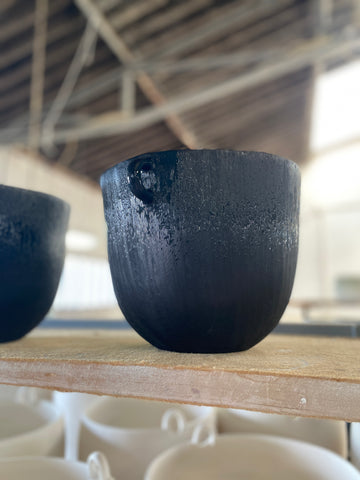Nowadays it’s more important than ever to know the sources and the process behind the products we deliver. That’s why we want you to take into the process behind our ceramics pieces and give you a scoop on what happens in the factories in Portugal.

Last March we visited our ceramics factories, nearby Lisbon. This region has a deep-rooted history in ceramics, due to the clay production from the Portuguese grounds. It has the perfect environment where minerals, plant life, and animals collide into soil. Over time, water pressure breaks up the remains of flora, fauna, and minerals, pulverizing them into fine particles. The larger remains are filtered through rocks and sand, settling in beds of clay.
This white clay is perfect for our ceramics, making it a beautiful natural source and giving an organic touch to our products, chosen for its quality and durability. The factories, we visited are specialized in decorative items like vases and tableware. Through various stages, each piece is made by hand under the eyes of skilled workers.
Where does the process of ceramics all start? At our HQ, here in Amsterdam, our design team makes technical drawings. Which are transformed into the first mock-up made from soft plaster; the so-called “Mother Mold”. This mold is the Mother of all molds and will serve as the base for the type of product.

Technical drawing with mold

Up to 15 to 200 molds would be filled every day with clay slip, sealed, and left to dry. How longer the clay stays in the mold, the thicker the wall of the vases or mugs will be. After a bit of drying out, the rough edges and imperfections will be scraped away or smoothed with a wet sponge.

Filling up the molds

Filled up molds

Making it smooth
At this moment in the process, it’s also possible to add some structure to the clay. This is made by hand, how personal is that? Every piece of our deco pot Honey is unique due to this. Have a look at the pictures below.

After the clay has found the perfect shape, it’s time to bisque. This is where the first firing happens in a kiln (an oven for ceramics) at a stunning 1162-1240℃ degrees, for 8-10 hours. During the firing process, raw clay turns into ceramic, making it ready for glazing.


What is glaze? It’s a liquid form of glass, consisting of ground-down glass particles mixed with pigments. It’s coating finished ceramic pieces and melts at a high temperature, giving it a decorative aesthetic and making it waterproof. Glaze can be sprayed on or dipped, after that it will be fired in the kiln for 12 hours. The pieces are afterward checked and ready to be shipped to your Urban Nature Culture dealer nearby.

Different shades of glaze



What we love about the process is that there is almost no waste. Every piece of clay that is thrown away during the making, will be used again. Look at the massive pile!

The leftovers will be collected and brought together to an even level of moisture and consistency so they can be used again. This will be done in a clay mill, making the whole process circular.
Next time you are looking at one of our vases, pottery or objects you know the background story. Hopefully giving a deeper connection and knowing the sources.

